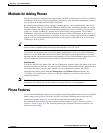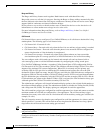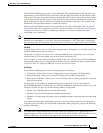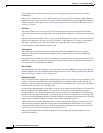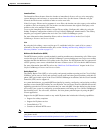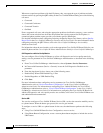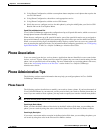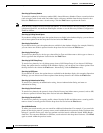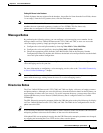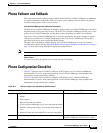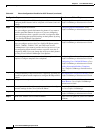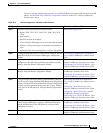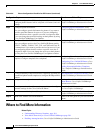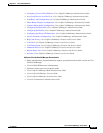
43-30
Cisco Unified CallManager System Guide
OL-14153-01
Chapter 43 Cisco Unified IP Phones
Phone Administration Tips
Cisco Unified CallManager User Options
Cisco Unified IP Phone users access Cisco Unified CallManager User Options through their web
browser, so they can configure a variety of features on their phone. Some of the configurable features
include user locale, user password, call forward, speed dial, and personal address book. By setting
enterprise parameters as either True or False, administrators can configure which features are made
available to users; for example, the administrator can set the Show Speed Dial Settings enterprise
parameter to False, and users cannot configure speed dials on their phones.
For more information on how to access and use Cisco Unified CallManager User Options, refer to the
phone guide for the specific Cisco Unified IP Phone.
Maximum Phone Fallback Queue Depth Service Parameter
The Cisco CallManager service uses the Maximum Phone Fallback Queue Depth service parameter to
control the number of phones to queue on the higher priority Cisco Unified CallManager when that Cisco
Unified CallManager is available for registration. The default specifies 10 phones per second. If a
primary Cisco Unified CallManager fails, the phones fail over to the secondary Cisco Unified
CallManager. The failover process happens as fast as possible by using the priority queues to regulate
the number of devices that are currently registering.
When the primary Cisco Unified CallManager recovers, the phones get returned to that Cisco Unified
CallManager; however, you do not need to remove a phone from a working Cisco Unified CallManager,
in this case the secondary system, as fast as possible because the phone remains on a working system.
The queue depth gets monitored (using the Maximum Phone Fallback Queue Depth service parameter
setting) to determine whether the phone that is requesting registration gets registered now or later. If the
queue depth is greater than 10 (default), the phone stays where it is and tries later to register to the
primary Cisco Unified CallManager.
In the Service Parameters Configuration window, you can modify the Maximum Phone Fallback Queue
Depth service parameter. If the performance value is set too high (the maximum setting specifies 500),
phone registrations could slow the Cisco Unified CallManager real-time response. If the value is set too
low (the minimum setting specifies 1), the total time for a large group of phones to return to the primary
Cisco Unified CallManager will be long.
Dependency Records
If you need to find what directory numbers a specific phone is using or to what phones a directory
number is assigned, choose Dependency Records from the Related Links drop-down list box on the
Cisco Unified CallManager Administration Phone Configuration or Directory Number Configuration
window. The Dependency Records Summary window displays information about directory numbers that
are using the phone. To find more information about the directory number, click the directory number,
and the Dependency Records Details window displays. If the dependency records are not enabled for the
system, the dependency records summary window displays a message.
For more information about Dependency Records, refer to the “Accessing Dependency Records” section
and the “Removing a Directory Number from a Phone” section in the Cisco Unified CallManager
Administration Guide.



